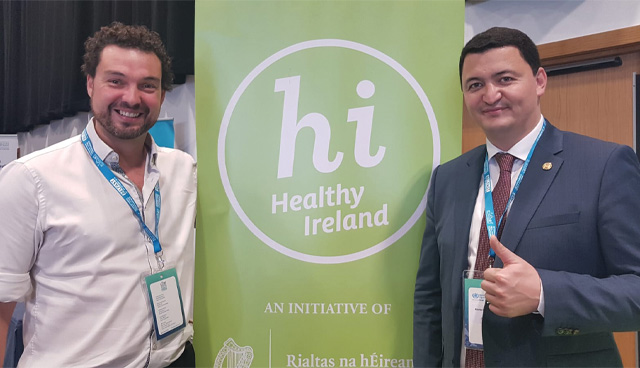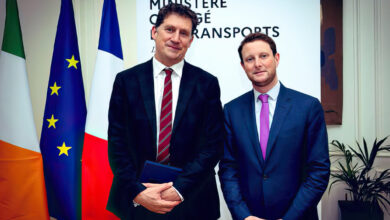The relationship between the environment and public health

Greg Straton, the Assistant Principal Officer of Health and Wellbeing at the Department of Health, speaks to eolas about Healthy Ireland and the work being done to create a whole-of-government understanding of how public health and the environment intersect.
“Healthy Ireland is a whole-of-government initiative aimed at improving the health and wellbeing of everyone living in Ireland,” Straton explains, adding: “The genesis of the framework is from the World Health Organisation’s regional European office. Health 2020 makes a clear connection between tackling the determinants of health and taking an all-of-government approach in the provision of the four goals of Healthy Ireland.
“The vision of Healthy Ireland is ensuring that everyone in Ireland can enjoy physical and mental health and wellbeing to their full potential, that that wellbeing is valued and supported at every level of society and is everyone’s responsibility across government.”
Goals and themes
The link between health and the environment informs Straton’s work. His responsibilities include striving for wellbeing to be valued and supported at every level through the four goals of Healthy Ireland, which are: increasing the proportion of people who are healthy at all stages of life; reducing health inequalities; protecting the public from threats to health and wellbeing; and creating an environment where every individual and sector of society can play their part in achieving a healthy Ireland.
“Goal two of the framework acknowledges that health and wellbeing are not evenly distributed across Irish society,” he says. “This goal requires not only interventions to address the wider health risks but also a broad focus to address the wider social determinants of health, such as the circumstances in which people are born, grow, work, live and age interact to create economic, social, cultural and physical environments that promotes healthy living.
“The goals themselves are to be addressed through a framework of actions organised under six themes. Under theme one, governance and policy, it is envisaged that every government department and their partner organisations would work with the Department of Health to produce coordinated plans to embed the Healthy Ireland thinking across government.
“The intention behind theme three, empowering people and communities, is to build awareness of and action on the social determinants of health, which assists communities to organise and mobilise around the challenges that affect their wellbeing. This is very much captured by the determinants model within the framework.”
Healthy Ireland Outcomes Framework
The Healthy Ireland Outcomes Framework, published in 2018, is based on a conceptual model for health and wellbeing, which incorporates health status, health outcomes and the determinants of health and wellbeing across the life course.
This acknowledges the interconnection between what Healthy Ireland is trying to achieve in health and other policy areas such as education, transport, and social protection, where there are significant overlapping agendas.
The range of indicators selected to support measurement of these outcomes means that government can work together to create an overall picture of health and wellbeing in Ireland. The three indicators chosen for the 2018 framework were air quality, water quality and radon, chosen “for their measurability and usefulness in predicting health outcomes”.
“Further inclusion of this data set could include indices on housing quality, utilisation of public and active transport, biodiversity and even land mass covered with indigenous forests,” Straton says.
“We’re currently looking at the Programme for Government commitment to develop a set of indicators to supplement economic measures of progress which take into account the wellbeing of the population. I believe that the approach taken by the Treasury Department of New Zealand in developing their Living Standards Framework is really an exemplar in this area.
“We are now progressing with plans to create a cross-sectoral governance group to oversee the framework’s ongoing development and use. This work will explore how best to use the Outcomes Framework to underpin health and wellbeing impact assessments, of relevant intersectoral policy areas and to support an evaluation and monitoring of impacts of government policies on the Healthy Ireland outcomes. These policy areas will be identified and selected with relevance to the Healthy Ireland agenda, targeting areas of policy with the greatest impact on quality of life.”
Healthy Ireland Fund
Key to the Healthy Ireland approach has been the Healthy Ireland Fund, which stimulates and supports innovative, cross-sectoral, evidence-based projects, programmes and initiatives that drive the implementation of key national policies.
The Fund uses a non-competitive approach to funding that enables partnership. Working at a community level, the first round of the Fund reached almost one million citizens, developed healthy county plans in 22 counties involving 504 organisations and delivering 382 actions at local level across Ireland involving 2,456 organisations.
Significantly, the Fund has been structured to allow for local people to identify needs and co-produce responses. This has resulted in 100 per cent uptake of the Fund by all those who are eligible. Examples of the initiatives supported by the Fund include the Royal Institute of Architects Ireland’s Town and Village Toolkit with Galway County Council, the Transport and Mobility Forum in Cork and the Baggot Estate native Wildflower/Biodiversity Garden in Limerick.

“Stakeholder and citizens engagement is at the centre of effective implementation of Healthy Ireland. Relationships and partnerships have been identified, built and strengthened. Additionally, since 2018, the communications and citizen engagement campaign, with the objective of positioning Healthy Ireland as a trusted source of information has been underway.”
“Cross-government and cross-societal collaboration is, we believe, the key achievement of the Fund,” Straton says. “The Fund pools the resources of other government departments. We have other departments putting money into the Fund, to implement multiple national policies at a local level in a coherent manner in a way that is citizen focused, locally relevant and tangible.
“The departments of Health, Education, Transport, Tourism and Sport, Children and Youth Affairs, and Rural and Community Development have contributed to its establishment and funding and continue to support its ongoing implementation.
“Stakeholder and citizens engagement is at the centre of effective implementation of Healthy Ireland. Relationships and partnerships have been identified, built and strengthened. Additionally, since 2018, the communications and citizen engagement campaign, with the objective of positioning Healthy Ireland as a trusted source of information has been underway.
“The Fund is distributed via local community development committees and children and young person’s services committees. Through these existing platforms, we believe that the engagement of citizens in local decision making can ensure that local organisations can work together.”
Another initiative the department has been involved in is the Warmth and Wellbeing Scheme, which is a deep retrofit scheme pilot that Straton sees as an “excellent example of the collaborative approach at the national level”. It was a collaboration between four national organisations: the Department of Environment, Climate and Communications, SEAI, the HSE and the Department of Health.
“This was very significant for us as we had a scheme being led by a different department where the main objective was to create a positive health outcome. From a Healthy Ireland point of view, this pilot exemplifies a cross-government approach to the provision of public services,” he adds.
Concluding, Straton looks to the future: “In the coming years we need to ensure that the sectors of society that control the most significant determinants of health and the environment realise that they play a huge role and take ownership of it. This will require those who work in the health system and environment to share ownership and expertise. Finally, we need to learn how to better utilise existing partnerships and platforms to drive change.
“The creation of a Healthy Ireland requires a culture change across Ireland to allow for the implementation across government and society. The Fund serves as a catalyst in the engagement with organisations and individuals across society with regard to health and wellbeing. This increased awareness is an important factor in the future prevention of chronic disease, which requires all sectors of society to play their part.”





